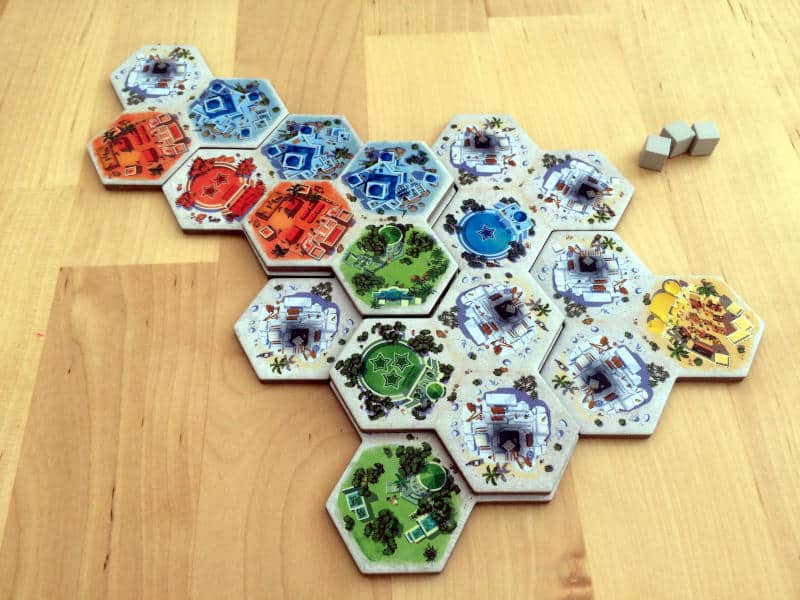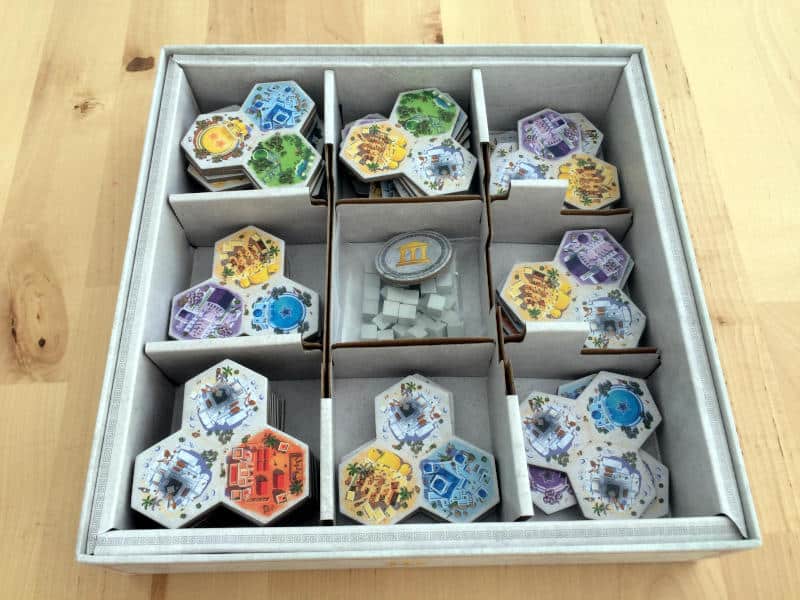| Release Date: 2022 | Players: 1-4 |
| Designer: Jules Messaud | Length: 30-45 minutes |
| Artist: Pauline Detraz | Age: 8+ |
| Publisher: Gigamic | Complexity: 1.5 / 5 |
| Plastic (by weight): <1% | Air (by volume): 65% |
It was the 5th century BCE and we, the Athenians, had been victorious over the Persians. The Delian League was now under our military control and the income generated by federation fees had made us prosperous. It was time for an ambitious building programme and the most talented architects in ancient Greece were ready. We were going to build housing, temples, markets, gardens and barracks. Our planning rules were going to create a harmonious community, enhanced by plazas. We would create new quarries to provide the stone to stretch our city towards the sky. We were going to build our high city, our Akropolis by Jules Messaud from Gigamic.
My introduction tries to drag this game into its historical context, but while the setting of Akropolis is very fitting and helps players understand the rules, it really is just an abstract tile-laying game with some clever placement rules. Yet, rather than being a Carcassonne clone with an added layer of tile drafting, Akropolis introduces an additional mechanism that literally lifts it up from other games. After all, Akropolis basically means “high city”. It’s the 3D element that makes the game so very different to anything else I’ve seen before. It’s the layering of tiles that adds another challenge for players aiming to score the most points.
Ground Level
Let’s start at ground level though and slowly work our way to the top. The tiles in Akropolis aren’t just squares, triangles or even hexes. No, they’re three hexes stuck together, creating a sort of triangular shape. That in itself can make your brain hurt a little, even when you love tile-laying games as much as I do. However, the shape is important, because it opens up many different possibilities for growing your city. Your aim is to place the different features in such a way as to score the most points at the end.
There are five different features overall, represented by five different colours, but also double-coded in the style of buildings depicted on each hex. Technically, there is a sixth feature, the white quarries, which provide the essential stone resource, but more to that later. Some features, or building types, want to be right next to each other, creating large areas of the same colour. Others need to be placed singly to score. Others again want to stay at the edge of your city to generate points.
So it is important to choose the right tile, find the best orientation for it and place it in the perfect spot in your city. That’s the main part of the game and is where you have to have an eye for patterns. It can be a gruelling thought process to find the best solution to this puzzle on every single one of your turns. Even for someone like me who is very visual and loves visual puzzles, Akropolis is rather challenging. I really have to focus and carefully consider my options.

Layering It Up
The game isn’t done with you yet though. While it’s tough enough to work in a single layer, if you really want to score a lot of points, you need to take your city to the second and possibly third level. If you’re really good, you might even be able to go four layers up, but I’ve not seen that in any game so far. The reason why you want to go higher is that buildings score more points. In simple terms, each one is worth one point per level it is on. So at ground level, each building is one point, one layer up it’s worth two and then three and so on. You can really multiply your score if you can manage to go higher.
Of course, as you layer tiles on top of each other, you’re also covering up the features underneath. The thing is, you score your city only at the end. It’s not like you get points when you place a tile. Every time you go up another layer, you could easily reduce your point total, if you’re not careful. So you have to choose wisely.
Luckily, quarries aren’t worth anything at the end of the game. They’re only useful when you cover them up with another tile. So as you grow your city onto another level, you’re trying to build over those quarries. For every quarry you block like this, you get one stone. Irritatingly, you don’t actually need stones for placing your tiles in your city, but you do need them for drafting tiles from the common market. That’s not very thematic, but is how the game works.
Drafting Akropolis
I guess I would have preferred if stone had been replaced with coins, because they’re basically payment. For drafting, Akropolis borrows a mechanism you have probably seen in other games, like Smallworld. The first tile is free, but the second, third or whatever number, which is based on player count, costs one, two or whatever number of stone resources. You place one stone on each tile you skip. So the more stone you have, the more options you have to choose from.
Even though it sounds simple enough to ensure you always have a good supply of stone, it’s not so easy. If you plan ahead, you might arrange your queries together, so that on a later turn, you can reap the reward of three stones on a single turn. The problem is, you don’t usually just want to place any old tile on top of your quarries. You want to ensure the tile fits with the building types surrounding the quarries so that you add to your final score. So while the perfect tile probably exists, it might not come out when you desperately need more stone resources. Or the perfect tile is further down the row in the market and you don’t have the stones to pay for it.
Of course, it’s not always necessary to go for a later tile in the market queue, but there will definitely be moments when you will curse yourself for not having enough stone to get the perfect tile that you so desperately need at that point in time. Of course, you might be lucky and that tile gets cheaper as other players take their tiles. Then again, chances are someone else will take the tile for themselves and you’re stuck with whatever second-rate tiles you can afford.

Puzzling Tiles
One more thing before I get to my conclusion. Akropolis has basically no plastic in it, except a baggie for the wooden cubes that represent the stones. I love that. However, Gigamic have gone one step further. They have managed to create a clever cardboard insert that keeps all the components in place – except for the wooden cubes. There is quite a lot of air in the box, but it’s not a large box in the first place. So, in this case, I can forgive that it’s not more compact. The insert makes more than up for it.
My wife and I have played Akropolis a lot. It works really well at two players, because other than the shared market, there is no direct player interaction. In fact, for anyone who prefers a multiplayer solitaire game, Akropolis will appeal to. For me, someone who loves tile-laying games with a clever little puzzle, this game is perfect. It takes it to another level, literally, by introducing the third dimension to the gameplay. It just makes the challenge of finding the right place for the right tile just that little bit harder, which is absolutely amazing. However, while it creates a bit of a headache, it’s not too hard.
Saying that, I appreciate the way tiles are placed and the addition of layering tiles can be confusing at first. Also, if you’re the sort of player who gets analysis paralysis when trying to choose the right tile and where to place it in other games of the genre, you might give Akropolis a miss. However, I absolutely love this game. It really suits my way of thinking and provides just the perfect level of difficulty. It gives me a real high.
Useful Links
- Akropolis: https://export.
gigamic. com/ akropolis-game/ - Rulebook: https://export.
gigamic. com/ wp-content/ uploads/ 2022/ 01/ GIGAMIC_ AKROPOLIS_ RULES_ EN_ 23-12. pdf - Gigamic: https://export.
gigamic. com/ - BGG listing: https://boardgamegeek.
com/ boardgame/ 357563/ akropolis - Carcassonne: https://boardgamegeek.
com/ boardgame/ 822/ carcassonne - Smallworld review: https://tabletopgamesblog.
com/ 2021/ 04/ 10/ smallworld-saturday-review/
Videos
Transparency Facts
I feel that this review reflects my own, independent and honest opinion, but the facts below allow you to decide whether you think that I was influenced in any way.- I played a friend's copy of the game.
- At the time of writing, neither the designers, nor the publisher, nor anyone linked to the game supported me financially or by payment in kind.
Audio Version
Intro Music: Bomber (Sting) by Riot (https://www.
Music by AShamaluevMusic.
Website: https://www.
Playlist
These are the songs I listened to while I was writing this review:

